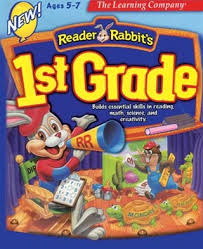The last few computer/video game retrospectives that I have written have all been working around the ClueFinders educational series. These games were designed to entertain and educate students between 3rd Grade and 6th Grade, acting as both late elementary school and middle school prep games. But before I ever played the ClueFinders series, my sister and I were introduced to an entirely different educational video game series. One focused far more on an even younger demographic, kindergartners and first graders. I am, of course, discussing the Reader Rabbit series.
In fact, it was through the Reader Rabbit franchise that my generation can lay claim to first true "educational video game" generation. We were the first to have video games and digital media form a core and essential part of our educational experience and preparatory work (as our school sold Reader Rabbit and ClueFinders games at the end of every year for students to play over the summer and prepare themselves for the next grades content ahead of time). Focusing on a variety of simple grammar and mathematics work, Reader Rabbit worked to provide a fun and simple way to slowly introduce children to concepts that they would further explore during school, a setup that was widely successful and led to The Learning Company (the production company) to become the name in educational gaming.
And while my personal emotional connection is tied far more to Reader Rabbit 2nd Grade (due to my memories of its more heartwarming story), I feel it is a tremendous disservice to the legacy of this franchise to not start with the first major computer game that my sister and I ever played together. A game which, while simple, did fantastic work in setting up kids for the world of Reader Rabbit, even if my sister and I only ever played two games in the series before we were transitioned into the ClueFinders.
Released in 1998 by The Learning Company, let's look back at Reader Rabbit: 1st Grade.
***
Like most games by The Learning Company,
Reader Rabbit:1st Grade isn't exactly a deep story, not that it really needs to be. Essentially the entire "plot" centers around Reader Rabbit and his friends putting on a theater performance for their hometown of Wordville. Everything is set up when Spike the Porcupine, jealous of being left out of the fun, decides to steal all of the scripts, costumes, and props, and artwork the day of the performance. Reader Rabbit has to calm down the townsfolk by promising to remake and recollect everything just a few hours before curtain call. THe game then follows him travelling through town completing various challenges and tasks to et everything ready before showtime and thwart Spike's efforts.
In terms of gameplay, Reader Rabbit: 1st Grade actually functions almost identically to the later ClueFinders games, though obviously with questions catered to an audience between the ages of 5 and 7. The game is comprised of 12 minigames, each focusing on the collection of a different part of the performance, including costumes and scripts, to props and advertisements. The topic of each game focuses on very basic grammar and mathematics, like the use of US cents or the ability to spot rhyming words, as well as generalized pattern recognition and reading comprehension.
All in all, the game provided a rather well-rounded if simple in hindsight approach to early elementary education. The fact that the game also used a primitive version of the learning software later seen in the ClueFinders games allowed more advanced to slightly challenge themselves with harder questions, though again not by much. If I had to pick out some favorite games that I remember playing as a child (obviously due to limitations of the software, Reader Rabbit: 1st Grade is basically impossible to play nowadays), then I would have to say Billboards and Costu-Matic were definite favorites in my memories.
I remember spending hours just messing around with Billboards, which was essentially a very simple Paint program that allowed quite a bit of creative freedom, though limited mostly by the subject matter and the technical limitations of the software. On the other hand, Costu-Matic was fairly easy to understand as the game operated as a vending machine for various costume parts that required the player to insert certain amounts or types of coins in order to retrieve the parts in question.
One criticism I will have is its tendency towards repetitiveness. The ClueFinders games had this challenge, but a slower game speed is easier for older and more mature children to handle, for Kindegartners and 1st Graders, the repetitiveness might sometimes get boring, even with the funny comments and impersonations.
The game absolutely has a simple and light-hearted tone throughout. The "villain" Spike is childish and mean but ultimately not a terrible kid and ends up being redeemed and welcomed by the other heroes after successfully putting on the performance. The game never loses sight of this simple premise and stays committed to remaining pleasant and good, a feeling that helps endear what might otherwise be a rather forgettable game to my memories. It worked too, as I still remember this game quite vividly, especially games like Word Bird which I have occasionally come across videos on YouTube about.
Speaking of, while I can't comment on how entertaining watching educational content for 1st graders would be to older audiences, watching videos of others playing may help to awaken your own memories of this hallmark of my childhood.
A fun, but simple, adventure that succeeds at its task at education, even with a perhaps slower pace then most really young children could maintain.
***
I
would like to thank my monthly Patrons for their support of all of my
content. You can join my Patreon for Behind-the-Scenes, Polls, and other
fan interactions here.
MONTHLY PATRONS
Cendoo


No comments:
Post a Comment